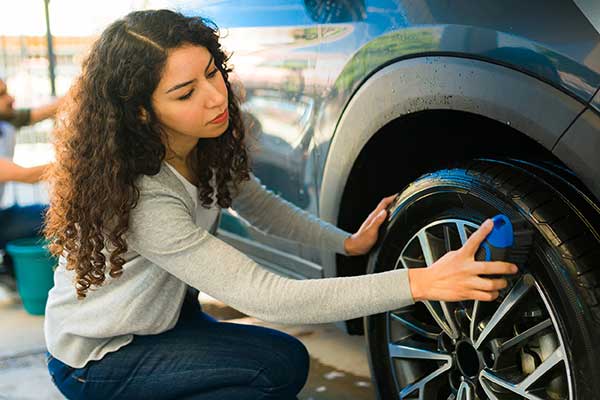Get your car ready for spring

Wax on, wax off
The salt and grime from winter roads can build up and cause rust and corrosion on your car’s exterior over time. Give it a thorough wash to remove any buildup, and follow that with a fresh coat of wax to protect your car’s paint and finish. Working in small sections, apply a thin layer using a poly foam applicator and buff with a microfiber towel. Work in the shade for better visibility and to prevent the wax from drying too quickly in the sun.
Pump it up (or down)
Changes in temperature mean fluctuations in tire pressure. Colder weather decreases tire pressure, while warmer temps can increase it. As we move into warmer weather, make sure your tires are at the optimal pressure as recommended by your owner’s manual. Adjusting the tire pressure also helps ensure you’re getting the best fuel economy and drivability from your vehicle.
Pop the hood
Cold temperatures can damage belts and hoses and make them brittle, so check to make sure there aren’t any cracks, leaks or hardening. While you’re under there, take a look at the levels of your power steering, brake, transmission and windshield washer fluids as well as your antifreeze. Top off any that are low — especially antifreeze since it will help prevent your car from overheating as temperatures rise in the coming months.
Line things up
If a few potholes have snuck up on you recently, you may want to check your suspension and alignment. Rough roads can damage your car’s suspension system and throw your wheels out of alignment. Make sure to have them inspected and adjusted as needed for optimal drivability.
Wipe it away
Winter weather can wreak havoc on your wipers, leaving them scratched, dry, cracked and worn down. Other factors, such as operating conditions, frequency of use, wiper materials and sunny weather can all impact how often your wipers need to be replaced. Don’t get caught without them — it’s a quick, inexpensive fix that’s critical to your safety on the road.
Get charged up
Can your battery handle the upcoming heat? Winters are hard on your car’s battery, but warm weather is also a real enemy. Hot temperatures outside mean it’s even hotter under the hood, which can accelerate corrosion and cause battery fluid to evaporate, resulting in decreased capacity and a shorter battery life. Have it tested and consider getting a new one if it’s more than a few years old.
Don’t let it sit
It is important to remember that just as our bodies need to move to stay healthy, our cars do too. Sitting too long can cause cars to have major issues, such as the battery potentially dying, flat spots developing on the tires and the engine oil deteriorating. It is recommended to start your car at least once a week, let it run for at least five minutes and make sure it gets plenty of ventilation.
If some or all of these tasks are out of your DIY comfort zone, leave it to the professionals and schedule an inspection with a mechanic to help ensure you stay safe on the road this spring and throughout summer.
Source: Car Care Council carcare.org